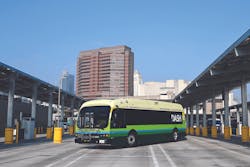Los Angeles Again Rolls Out Big Microgrid Plans, This Time for Transportation Electrification
Greater Los Angeles, California, is emerging as an innovation hub for microgrids, evidenced most recently by a plan to install what is being described as one of the US’ largest EV charging stations powered by a solar and storage microgrid.
The Washington Bus Yard project comes as the Los Angeles Department of Transportation (LADOT) works to transition to an all-electric fleet by 2028 under a Green New Deal plan put forward by Los Angeles Mayor Eric Garcetti.
“Los Angeles is on track to achieve a zero-emission future and our investments in clean transportation systems are driving that progress,” Garcetti said. “The more electric vehicles we put on our streets today, the more we can lower emissions to ensure a healthier, more sustainable tomorrow.”
With a $6 million grant from the California Energy Commission (CEC), the solar and storage microgrid will serve a 7.5-MW EV charging system, making it what vendor Proterra Energy describes as one of the largest projects of its kind in the US. Its power will come from 1.5 MW of rooftop and canopy solar paired with 4.5 MWh of energy storage. The microgrid will power five 1.5-MW fleet chargers with 104 remote EV charging dispensers.
Washington Bus Yard project budget from CEC grant application
The microgrid is meant to help the transportation department reach its electrification goals at the lowest cost possible, while minimizing the impact on the electric grid and providing resiliency, according to the grant application submitted to the CEC.
Proterra Energy, a California-based manufacturer of EVs and charging equipment, will provide the charging infrastructure. Proterra also recently delivered its 25th battery-electric transit bus to LADOT. Apparent, an energy management company, also based in California, is supplying the operating system platform.
Announcement of the project follows the release of a sweeping plan in September by the County of Los Angeles to create a $41 million program that includes a regional microgrid agency to serve an area that encompasses roughly half of California’s population. The Regional Public Agency Microgrid Program would act as a centralized resource to help local governments and public agencies implement microgrids.
The county introduced the idea to the California Public Utilities Commission (CPUC) after the commission requested ideas about how to overcome a projected electric capacity shortfall in the state.
The regional microgrid agency did not make the cut in a recent advisory issued by a state administrative law judge. However, the judge did recommend that the county seek funding through the state’s $200 million microgrid incentive program for three microgrids that it proposed as part of the plan.
The CPUC will vote on the administrative law judge’s proposed decision at its Dec. 2 meeting.
Separately, the Port of Los Angeles has included a microgrid within its Green Omni Terminal Demonstration Project, which is designed to meet the port’s energy needs from renewable sources.
Track news about solar and storage microgrid, electrification and the energy transition. Subscribe to the free Microgrid Knowledge Newsletter.
About the Author
Elisa Wood
Editor-in-Chief
Elisa Wood is the editor and founder of EnergyChangemakers.com. She is co-founder and former editor of Microgrid Knowledge.
